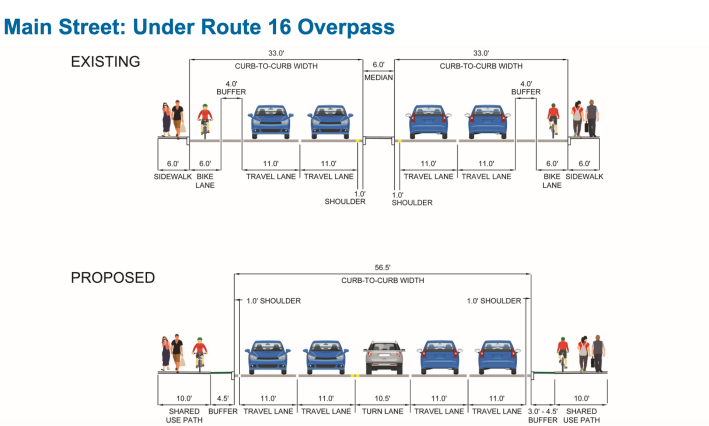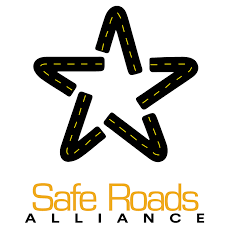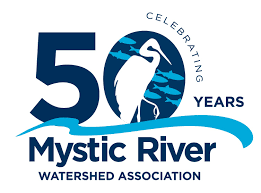MassDOT is redesigning a high-crash intersection in downtown Medford; however, their plans currently include preserving an outdated highway overpass whose ramps are the the site of many of the crashes in the area.
The plans would also result in a reduction of the amount of space for bikes and pedestrians between downtown Medford and the neighborhoods to the south. As seen by the public response, these major infrastructure changes along Medford’s Main Street are not quite meeting the community’s needs or standards.
A high-crash gateway to downtown Medford
The intersection of Main Street with the eastbound on- and off-ramps to Route 16 ranks as one of the state's top 50 worst locations for crashes, and it's one of the only ways for pedestrians and bikes to access Medford Square from the southern side of the Mystic River.
By the Numbers

These numbers have created a sense of urgency for the city to protect its community members. In 2021, MassDOT installed some interim improvements, repainting lane markings and installing temporary barricades at the intersection of Main and South Streets.
These interventions allowed for vehicles on South Street to turn left or right onto Main Street, but prohibited them from continuing straight onto I-93, clarified Main Street's northbound lanes designating one straight lane and one right turn lane towards Medford Square and I-93, and restricted left turns from Main Street southbound towards Somerville and Boston onto I-93.
MassDOT proposes to add more lanes
In May, MassDOT hosted a virtual public meeting to describe some more robust changes they’d like to make to these intersections.
MassDOT’s proposed plan includes reconstructing the three intersections where Main Street meets the Route 16 westbound ramps, the Route 16 eastbound ramps, and the intersection with Mystic Avenue and Emerson Street.
MassDOT told audience members that they aim to enhance safety by encouraging safe speeds and improving visibility for pedestrians and cyclists, reconstructing pedestrian sidewalks and curb ramps, and creating buffered bicycle lanes and a shared-use path.
The proposal would reconfigure three intersections along Main Street between Mystic Avenue and the Mystic River, adding new traffic signals, turn lanes, and some bike lanes.
However, amidst all these proposed changes, MassDOT still wants to keep the crumbling highway overpass – a type of infrastructure the agency has called “obsolete” in other contexts, like Rutherford Avenue and the McGrath Highway.
That decision severely constrains how much space will be available for bikes and foot traffic through these intersections.
The existing Main Street has four motor vehicle lanes, plus two six-foot-wide bike lanes and sidewalks under the Route 16 overpass.
The new MassDOT proposal would force bikes and pedestrians to squeeze into 10-foot-wide “shared-use paths” to make room for a fifth car lane in the roadway:

Local bike and pedestrian advocates push back
The Medford Bike Commission convened a special meeting on May 13 to discuss MassDOT’s plans.
Jared Powell, a Commission member, called MassDOT’s proposal “disappointingly typical.”
“There’s way too many lanes, all over the place,” said Powell. “I don’t know why maximizing vehicle throughput is the goal here. That’s currently why Medford Square is currently so atrocious for pedestrians and cyclists.”
Several Commission members observed that there are plans in the works to build new riverfront pathways that would connect to Main Street, including the under-construction Clippership Connector and another proposed new path on the southern bank of the river.
“We are hoping that the number of people on bikes and on foot will increase over time, and these (proposed 10-foot paths) are not adequate,” said Commission chair Emily O’Brien.
Rebekah Wright, who regularly bikes through these intersections from Medford Square to South Medford, said “it’s not great right now, but this is definitely a step backwards, and it doesn’t feel safer.”
Local advocacy groups WalkMedford, Safe Roads Alliance, Mystic River Watershed Association, and Mothers Out Front of Medford, as well as local elected officials and dozens of Medford residents have co-signed an open letter to Massachusetts Department of Transportation Chief Engineer Lavallee requesting a meeting or a place-based walk audit with MassDOT to discuss potential changes to the project.





While the advocates express gratitude for the project's progress and emphasize the critical role of Main Street as a vital connector for pedestrians, cyclists, and transit users in Medford, they also push the project staff to prioritize community safety and health, and to reduce emissions and promote alternative transportation modes over car traffic.
The advocates argue that adding a fifth lane under the Route 16 overpass and on South Street contradicts goals of traffic calming and safety, and potentially increases dangerous driving behaviors and speeds.
The letter also criticizes the decision to retain the Route 16 highway ramps, which, they argue, are outdated and detrimental to the urban and environmental character of the area, and obstruct critical pedestrian and bike connections.
Other calls in the letter include focusing on simplifying pedestrian crossings, separating cycling infrastructure from pedestrian paths, prioritizing high-frequency bus routes, reallocating lanes to prioritize bus transit, ensuring protected transit stops, and maximizing green spaces and tree coverage along the river and roadways to enhance environmental benefits and corridor appeal.
The authors stress the importance of balancing urgency with intentionality to demonstrate the power of good urban street design, to remediate past harms done to Medford’s livability, walkability, public transit, safety and local river ecology, saying “whatever we design and build now, the residents of Medford will be saddled with for another two generations.”
StreetsblogMASS reached out to MassDOT to ask why the agency is deciding to keep the Mystic Valley Parkway highway overpass, when the agency is making plans to tear down similar highway infrastructure in other projects nearby.
The office said a preliminary traffic analysis indicated that grounding the Mystic Valley Parkway with Main Street is not feasible based on projected traffic conditions, and any further study and work needed in design, engagement, and construction would further delay any corrective measures at the intersection.
We also asked why the roadway is being expanded to five lanes while all the adjacent streets are only two lanes wide, despite previous MassDOT statements against “roadway expansion as a means to reduce congestion.”
MassDOT’s spokesperson simply reiterated that their priority goal is to “improve safety at a high crash location.”
MassDOT’s next steps in this project will look like completing 25% of the design phase by this summer or fall, conducting a Design Public Hearing this winter, reaching a 75% complete design by spring of next year, achieving a complete design by Summer 2025, and advertising the project a year later.
The full presentation from the May public meeting on the project can be found here, and more details on the project can be found here.







